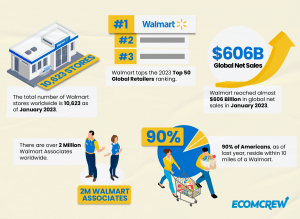History of Walmart

People recognize Walmart, the largest retail corporation in the world as a household name of convenience, affordability, and a vast selection of products. But how did this retail powerhouse come into existence? In this blog, we will delve into the captivating history of Walmart, tracing its remarkable journey toward becoming a global retail phenomenon.
Walmart Statistics
Even up to this day, Walmart succeeded in solidifying its presence.

Walmart's Establishment and Sam Walton's Vision
The establishment of Walmart marked the beginning of a retail revolution, driven by the aspirations of its founder, Sam Walton. With his concept of affordability and exceptional service, Walton's vision built a solid foundation for Walmart's subsequent growth and success.

What Made Walmart Stand Out?
The competitive edge of Walmart consists of the following five factors:
- Satisfying Customer Service
Walmart, evident in its friendly and knowledgeable store associates, contributes to a positive shopping experience. The company actively improves customer service through training programs for its employees. Moreover, Walmart offers a ninety-day return policy without receipt, which favors customers who want to return or exchange products.
- Efficient Supply Chain Management
The company developed a sophisticated inventory management system, utilizing advanced technologies to optimize stock levels, reduce waste, and minimize out-of-stock situations. Also, this operational excellence guarantees that the stores are well-stocked, providing customers with a wide selection of products.
- Innovative Investment in E-Commerce
As Walmart made E-Commerce investments, online sales reached 27% in the first quarter of fiscal 2023. Through its online platform, people can conveniently shop for products from their homes. Their seamless integration of online and offline retail experiences ensures customers have flexible shopping options to meet their needs.
- Low-Price Standpoint
Walmart's mission is “to save people money so they can live better.” The company leverages its negotiation with suppliers by buying goods in bulk. Walmart maintains its prices low through its extensive network of stores, distribution centers, and logistics capabilities, allowing it to drive down costs and pass on savings to customers.

- Established Global Presence
As of this writing, Walmart operates in twenty countries, which allows the company to serve diverse customer bases and adapt to different market dynamics. Also, Walmart International has more than 5,100 retail units and approximately 550,000 associates worldwide, reinforcing its position as a global retail leader.
Walmart's Issues and Controversies
As with any business, even Walmart has faced setbacks through its years of service. Here are just four of Walmart’s issues and challenges:
- Impact on Small Businesses
Small retailers see dramatically lower sales when consumers prefer to shop at this retail giant, and some are now forced to sell their goods at a lower price. Some argue that the company's aggressive expansion can lead to the closure of local businesses, altering the fabric of communities and causing job losses. In fact, the term used to describe the impact on small local businesses when big corporations come in is the Walmart Effect.

- Worker Rights and Compensation
For years, employees have questioned Walmart's commitment to treating them fairly and paying them a living wage. These controversies highlight the continuous discussion over worker rights and how to strike a balance in the retail sector between corporate interests and employee welfare.
- Negative Environmental Impact
Walmart has faced scrutiny for its environmental practices, including concerns over energy consumption, waste generation, and carbon emissions. Many say that the business should make more significant efforts to lessen its impact on the environment and advance sustainability.
It is crucial to remember that while these shortcomings have been recognized, Walmart has also made efforts to fix them over time.
Walmart’s Timeline and History
Walmart's progression is evidence of its innovative spirit and persistent dedication to customer satisfaction. Starting as a single discount store in 1962, Walmart, founded by Sam Walton, rapidly grew into a retail giant. Today, Walmart stands as a global retail powerhouse, serving millions of customers worldwide and continuously shaping the retail landscape.

1962: Sam Walton founded Walmart in Rogers, Arkansas, USA.
1967: The company opened 24 stores in the state of Arkansas.
1970: Walmart becomes a publicly traded company.
1972: Walmart gets listed on the New York Stock Exchange.
1979: Walmart becomes a billion-dollar company.
1980: Walmart reaches $1 billion in annual sales, quicker than any other company.
1990: Walmart surpasses all other retailers to take the top spot in the country.
1991: As part of its global development, Walmart opens its first location outside of the US in Mexico City.
1992: Walmart introduces the concept of “Supercenters,” combining a full-scale grocery store with general merchandise.
1995: Walmart launches its website, Walmart.com, enabling customers to shop online.
2000: Walmart.com launches, which allows U.S. customers to shop online.
2002: Walmart tops as the largest company in America on the Fortune 500 list.
2005: Walmart launches its sustainability initiative, aiming to be supplied 100% by renewable energy, create zero waste, and sell sustainable products.
2016: Walmart Pay, a quick, simple, and safe way for customers to use their smartphones to make purchases, becomes a well-liked in-store payment option.
2019: Walmart introduces next-day delivery for online orders in the United States.
2020: Walmart launches Walmart+, a membership program offering free delivery, fuel discounts, and other benefits.
2021: Walmart begins piloting drone delivery, fintech, and autonomous vehicles
2022: Walmart expands InHome Delivery to 30 million homes in the United States.
What Led to Walmart's Success?
Sam Walton, the founder of Walmart, had a visionary approach to retail. He believed in providing value to customers, embracing innovation, and fostering a strong company culture. Walton's philosophy focused on building strong relationships with both customers and employees, which became the cornerstone of Walmart's success.
Expansion and the Birth of the Walmart Supercenter
In 1969, Walmart went public and started trading on the New York Stock Exchange. With the newfound capital, the company embarked on an ambitious expansion plan. By the end of the 1970s, Walmart had grown to include 276 stores and had expanded beyond its Arkansas roots to neighboring states.
One of the significant milestones in Walmart's journey was the introduction of the Walmart Supercenter in 1983. This groundbreaking concept combined a traditional Walmart store with a grocery store, providing customers with a one-stop shopping experience. The Walmart Supercenter quickly gained popularity, attracting a wide customer base.
Technological Innovations and Supply Chain Management
Walmart has always been at the forefront of embracing technology to enhance its operations. In the 1980s, the company made significant investments in computer systems, streamlining inventory management and improving overall efficiency. This allowed Walmart to offer a wide variety of products to its customers while maintaining competitive prices.

Another key factor behind Walmart's success is its innovative approach to supply chain management. Walmart revolutionized the retail industry by implementing advanced logistics and distribution systems. Thus, Walmart was able to lower expenses, increase product availability, and provide customers with savings, further establishing its position as the industry leader.
International Expansion and Sam's Club
In the early 1990s, Walmart expanded its market share outside of the US by entering other markets through acquisitions and strategic alliances. Today, Walmart operates in multiple countries worldwide, serving millions of customers.
In 1983, Walmart introduced Sam's Club, a membership-based warehouse club that offered bulk products at discounted prices. Sam's Club quickly became a successful venture, catering to both individual shoppers and businesses. Walmart proceeded to diversify its revenue sources and increase its client base with its wide selection of products and services.
Embracing E-Commerce and Digital Transformation
Walmart recognized the importance of E-Commerce and made strategic investments to bolster its online presence. The business introduced Walmart.com, an online storefront offering a variety of goods to customers all around the United States, in 2000. Since that time, Walmart has kept growing its online business and adjusting to the changing digital environment.

Walmart has embraced various technological advancements, including automated fulfillment centers, cashierless stores, and delivery innovations. Through these endeavors, Walmart has been able to provide customers with seamless shopping experiences that combine the advantages of both physical and online retail.
Final Thoughts
Walmart's success did not happen overnight; it's more than 60 years in the making. While they are now considered a globally-dominant business, many challenges, limitations, and changes affected their overall growth through the years.
There's an immense history in Walmart's legacy that most people don't know. From its unassuming start to its expansion, Walmart has maneuvered retail by embracing new technologies and trends while uncovering ways to rise against the competition.



